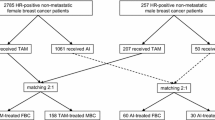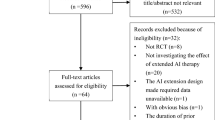Abstract
To determine the impact of adjuvant treatment with tamoxifen and aromatase inhibitors (AI) on the survival of men with breast cancer. We analyzed 257 male patients with hormone-receptor-positive breast cancer from numerous German population-based cancer registries treated with tamoxifen (N = 207) or aromatase inhibitors (N = 50). The median follow-up was 42.2 (range 2–115) months. Median age at diagnosis was 68 (range 36–91) years. Thirty-seven (17.9 %) patients treated with tamoxifen and 16 (32.0 %) patients treated with AI died (log rank p = 0.007). After the adjustment for the patient’s age, tumor size, node status, and tumor grading, the AI treatment was linked to a 1.5-fold increase in risk of mortality compared to tamoxifen (HR 1.55; 95 % CI: 1.13–2.13; p = 0.007). The overall survival in male breast cancer was significantly better after adjuvant treatment with tamoxifen compared to an aromatase inhibitor. Tamoxifen should be considered as the treatment of choice for hormone-receptor-positive male breast cancer.

Similar content being viewed by others
Abbreviations
- AI:
-
Aromatase inhibitors
- CI:
-
Confidence interval
- DCIS:
-
Ductal carcinoma in situ
- ER:
-
Estrogen receptor human epidermal growth factor
- HER2:
-
Receptor 2
- HR:
-
Hazard ratio
- MBC:
-
Male breast cancer
- N:
-
Number
- OS:
-
Overall survival
- PR:
-
Progesterone receptor
- TAM:
-
Tamoxifen
References
Fentiman IS, Fourquet A, Hortobagyi GN (2006) Male breast cancer. Lancet 367:595–604
Korde LA, Zujewski JA, Kamin L (2010) Multidisciplinary meeting on male breast cancer: summary and research recommendations. J Clin Oncol 28(12):2114–2122
Giordano SH, Cohen DS, Buzdar AU et al (2004) Breast carcinoma in men: a population-based study. Cancer 101:51–57
Agrawal A, Ayantunde AA, Rampaul R et al (2007) Male breast cancer: a review of clinical management. Breast Cancer Res Treat 103:11–21
Contractor KB, Kaur K, Rodrigues GS et al (2008) Male breast cancer: is the scenario changing. World J Surg Oncol 6:58
Cardoso F, Costa A, Norton L, et al (2012) 1st International consensus guidelines for advanced breast cancer (ABC 1). Breast doi:10.1016/j.breast.2012.03.003
Lück HJ, Lux M (2012) Breast cancer: specific situations in Deutsche Gesellschaft für Gynäkologie und Geburtshilfe (ed):Diagnosis and treatment of patients with primary and metastatic Breast cancer v. 2012.1, Arbeitsgemeinschaft Gynäkologische Onkologie e.V. http://www.ago-online.de/de/fuer-mediziner/leitlinien/mamma/ (zip file, English version, pp 260-261)
Oxford Centre for Evidence-based Medicine—Levels of Evidence (March 2009) http://www.cebm.net/index.aspx?o=1025
Giordano SH (2005) A review of the diagnosis and management of male breast cancer. Oncologist 10:471–479
Cutuli B, Lacroze M, Dilhuydy JM et al (1995) Male breast cancer: results of the treatments and prognostic factors in 397 cases. Eur J Cancer 31A:1960–1964
Weber-Chappuis K, Bieri-Burger S, Hurlimann J (1996) Comparison of prognostic markers detected by immunohistochemistry in male and female breast carcinomas. Eur J Cancer 32A:1686–1692
Fogh S, Hirsch AE, Langmead JP et al (2011) Use of tamoxifen with postsurgical irradiation may improve survival in estrogen and progesterone receptor-positive male breast cancer. Clin Breast Cancer 11:39–45
Giordano SH, Perkins GH, Broglio K et al (2005) Adjuvant systemic therapy for male breast carcinoma. Cancer 104:2359–2364
Goss PE, Reid C, Pintilie M et al (1999) Male breast carcinoma: a review of 229 patients who presented to the Princess Margaret Hospital during 40 years: 1955–1996. Cancer 85:629–639
Harlan LC, Zujewski JA, Goodman MT et al (2010) Breast cancer in men in the United States: a population-based study of diagnosis, treatment, and survival. Cancer 116:3558–3568
Ribeiro G, Swindell R (1992) Adjuvant tamoxifen for male breast cancer (MBC). Br J Cancer 65:252–254
Ribeiro G (1983) Tamoxifen in the treatment of male breast carcinoma. Clin Radiol 34:625–628
Salvadori B, Saccozzi R, Manzari A et al (1994) Prognosis of breast cancer in males: an analysis of 170 cases. Eur J Cancer 30A:930–935
Nordman IC, Dalley DN (2008) Breast cancer in men: should aromatase inhibitors become first-line hormonal treatment? Breast J 14:562–569
Baum M, Budzar AU, Cuzick J et al (2002) Anastrozole alone or in combination with tamoxifen versus tamoxifen alone for adjuvant treatment of postmenopausal women with early breast cancer: first results of the ATAC randomised trial. Lancet 359:2131–2139
Coates AS, Keshaviah A, Thurlimann B et al (2007) Five years of letrozole compared with tamoxifen as initial adjuvant therapy for postmenopausal women with endocrine-responsive early breast cancer: update of study BIG 1–98. J Clin Oncol 25:486–492
Coombes RC, Hall E, Gibson LJ et al (2004) A randomized trial of exemestane after two to three years of tamoxifen therapy in postmenopausal women with primary breast cancer. N Engl J Med 350:1081–1092
Volm MD (2003) Male breast cancer. Curr Treat Options Oncol 4:159–164
Zumoff B, Fishman J, Cassouto J et al (1966) Estradiol transformation in men with breast cancer. J Clin Endocrinol Metab 26:960–966
Mauras N, O’Brien KO, Klein KO et al (2000) Estrogen suppression in males: metabolic effects. J Clin Endocrinol Metab 85:2370–2377
Ellinwood WE, Hess DL, Roselli CE et al (1984) Inhibition of aromatization stimulates luteinizing hormone and testosterone secretion in adult male rhesus monkeys. J Clin Endocrinol Metab 59:1088–1096
Shetty G, Krishnamurthy H, Krishnamurthy HN et al (1998) Effect of long-term treatment with aromatase inhibitor on testicular function of adult male bonnet monkeys (M. radiata). Steroids 63:414–420
Roselli CE, Resko JA (1997) Sex differences in androgen-regulated expression of cytochrome P450 aromatase in the rat brain. J Steroid Biochem Mol Biol 61:365–374
Early Breast Cancer Trialists’ Collaborative Group: Tamoxifen for early Breast cancer: an overview of the randomised trials. Lancet 351:1451–1467, 1998
Powles TJ, Ashley S, Tidy A et al (2007) Twenty-year follow-up of the Royal Marsden randomized, double-blinded tamoxifen breast cancer prevention trial. J Natl Cancer Inst 99:283–290
Acknowledgments
We would like to thank Mathias Uhlig, PhD, Sabine Kleinefeld, and Christiane Praetor for their excellent work in project and data management.
We would also like to thank the following cancer registries for their cooperation, without which this study would not have been possible: Tumorzentrum Augsburg, Krebsregister in Klinikum Bayreuth GmbH, St. Gertrauden-Krankenhaus (Tumorzentrum gemeinnütziger und konfessioneller Krankenhäuser in Berlin (TZGKB)), Vivantes Tumorzentrum (Berlin), Tumorzentrums Chemnitz e.V., Tumorzentrum of the Staedische Klinikum in Dessau, Tumorzentrum Erfurt e.V., Tumorzentrum Ludwig Heilmeyer (Comprehensive Cancer Center Freiburg), Arbeitsgruppe zur Koordination Klinischer Krebsregister (AKKK) Giessen, Tumorzentrum Ostsachsen e. V. Goerlitz, Tumorzentrum Halle, Gynaekologisches Tumorzentrum am Diakonie-Klinikum Hamburg, Tumorzentrum Heilbronn-Franken, HELIOS Klinikum Berlin Buch, UniversitätsTumorCentrum Jena, Tumorzentrum Koblenz am Kemperhof, Tumorzentrum Land Brandenburg, Tumorzentrum Magdeburg/Sachsen-Anhalt e.V., Tumorzentrum Neubrandenburg, Tumorzentrum Südharz e.V. in Nordhausen, Krebsregister Rostock, Tumorzentrum Schwerin-Westmecklenburg, Tumorzentrum Suhl e. V., and the Tumorzentrum Zwickau e.V.
Conflict of interests
The authors declare no conflicts of interest.
Author information
Authors and Affiliations
Corresponding author
Rights and permissions
About this article
Cite this article
Eggemann, H., Ignatov, A., Smith, B.J. et al. Adjuvant therapy with tamoxifen compared to aromatase inhibitors for 257 male breast cancer patients. Breast Cancer Res Treat 137, 465–470 (2013). https://doi.org/10.1007/s10549-012-2355-3
Received:
Accepted:
Published:
Issue Date:
DOI: https://doi.org/10.1007/s10549-012-2355-3




